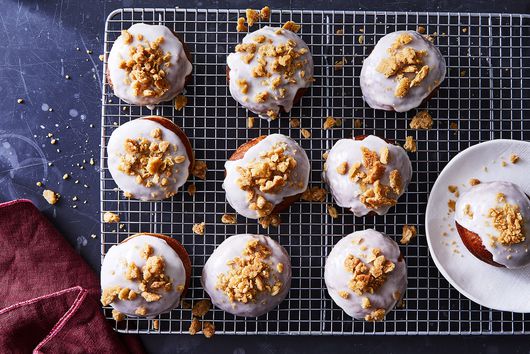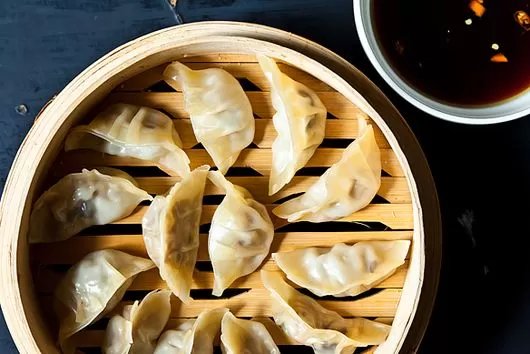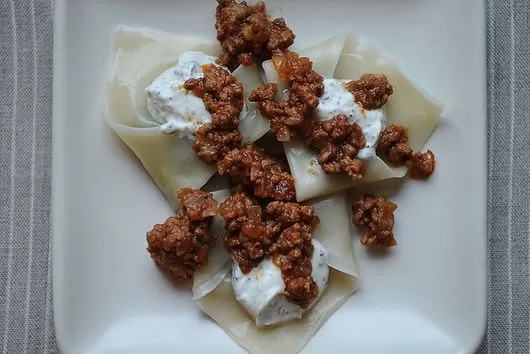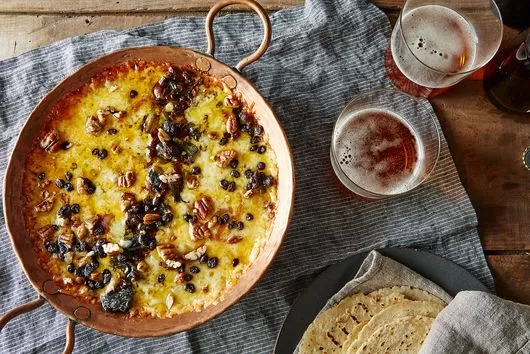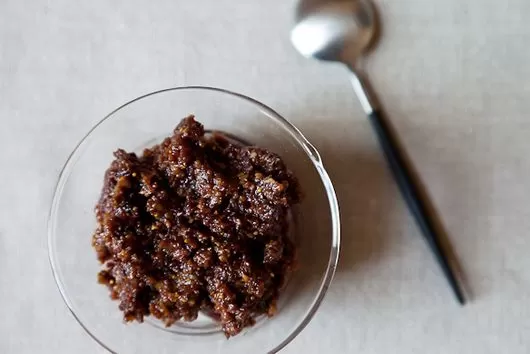Glazed Oat Milk Doughnuts With Streusel
MAKES
12 doughnuts
Ingredients
For the doughnuts:
72 grams
(6 Tbsp) aquafaba, or about 1/2 the liquid from 1 can of chickpeas, drained
5 grams
(2 tsp) ground flaxseed
200 grams
(1 cup) Planet Oat Original Oatmilk
57 grams
(1/4 cup) vegan butter or coconut oil, melted
364 grams
(3 cups) bread flour
90 grams
(3/4 cup) all-purpose flour
4 grams
(2 tsp) cardamom
2 grams
(1 tsp) cinnamon
14 grams
(1 tsp) kosher salt
5 grams
(1 1/2 tsp) quick-rise yeast
For the oat milk pastry cream:
400 grams
(2 cups) Planet Oat Original Oatmilk
12 grams
(1 Tbsp) vanilla extract or 1 vanilla bean split and insides scraped with a small paring knife
120 grams
sugar
60 grams
(1/2 cup) cornstarch
60 grams
(4 Tbsp) cold vegan margarine, cut into cubes
26 grams
(2 Tbsp) brown sugar
12 grams
(2 Tbsp) rolled oats
Pinch of salt
28 grams
(2 Tbsp) cold vegan butter or margarine
For the glaze:
223 grams
(2 cups) powdered sugar
60 grams
(1/4 cup) Planet Oat Original Oatmilk
Zest and juice of 1/2 lemon (optional, but delicious)
Ingredients
- Make the dough: Mix the aquafaba with the ground flaxseed in a small bowl. Set aside and let the flax bloom. It will become thick and somewhat viscous; this is good.
- Warm the oat milk, vegan butter or coconut oil, and a pinch of sugar in a saucepan till it reaches 105°F to 115°F. Remove the pan from heat and sprinkle yeast over the top, mixing to lightly combine. Let this mixture sit 5 minutes to bubble and activate; it may look like curdled milk when it's done, but don’t fret.
- In the meantime, place the dry ingredients in the bowl of a stand mixer, and mix to combine with a paddle attachment. With the mixer running on low, pour in the yeast-oat milk mixture and aquafaba mixture. Mix with the paddle attachment just until a cohesive dough forms. Stop the mixer to scrape down the sides and bottom of the bowl, then switch to the dough hook. Knead with the dough hook on low speed for about 7 minutes, scraping down with a spatula when necessary. After 7 minutes you should have a smooth, shiny, elastic dough that bounces back slightly when poked
- Lightly grease a large mixing bowl and add your bouncy-shiny dough to it. Turn the dough in the bowl to coat in any residual oil, then cover with clingfilm and set aside 1 hour or until doubled in size. Depending on how warm your kitchen is this time may be more or less. While the dough rises, you can begin to prepare the pastry cream and streusel so they both have enough time to cool.
- Make the pastry cream: Add the oat milk and vanilla extract (or the vanilla bean and its inside seeds) to a small pot, and warm over medium heat until bubbles form around the sides of the pan. Turn off the heat. If using a vanilla bean, set the mixture aside to let it infuse with the vanilla flavor for 10 to 15 minutes, then remove the vanilla bean and continue on.
- In a small, heat-proof bowl, whisk together the sugar, cinnamon, and cornstarch just to combine. Using a steady hand, slowly stream roughly half of the warm oat milk into the sugar and cornstarch bowl whisking constantly and continuously to make a kind of slurry. If you have a few lumps here and there it's alright, just continue to whisk to try and help them dissolve further. In the end, we will strain our pastry cream and any really stubborn bits should be resolved then.
- Add this slurry back to the pot with the remaining mixture, stirring over medium-low heat for 2 to 3 minutes to thicken (a whisk or heat-proof spatula is excellent here). Around this time you should notice some larger, slower bubbles forming; your spatula or whisk will leave a small trail behind it as you stir and your mixture should be quite thick and smooth.
- Take the pot off the heat and add the margarine, swirling into the warm pastry cream until dissolved. If you notice any lumps at this step, use a fine-mesh strainer over a bowl and strain the pastry cream, scraping and pushing it through with the sides of your spatula. Once lump-free, cover the surface of the cream with cling film and let chill in the fridge to thicken further.
- Make the streusel: Preheat the oven to 325*F. Whisk together the flour, sugar, oats, and salt in a small mixing bowl. Then work in the vegan butter, mixing until coarse crumbs form.
- Spread the mixture on a parchment-lined baking sheet and bake for 10 to 12 minutes, stirring often until the streusel is golden brown. Remove from the oven and cool completely.
- Prep the doughnuts: Once the dough has risen, set aside two 9- x13-inch pans (the doughnuts will do their second rise in there). Cut twelve 4- x 4-inch squares of parchment paper (this will make transferring your doughnuts to the oil much, much easier later).
- Gently tip the risen dough out onto a floured surface. With a rolling pin, roll out the dough to a large rectangle with a 1/2-inch thickness; it does not need to be perfect. Using a 3-inch round cutter, or lip of a sturdy glass of similar circumference, cut 12 doughnuts into the dough. Transfer each doughnut to a piece of parchment and divide evenly between the 9- x 13-inch pans. Cover both pans again with cling film and let rise in a warm, draft-free place for 25 to 30 minutes (depending on how warm again your kitchen is).
- Note: By placing the doughnuts in a flat layer in the pan, this gives some head room for the doughnuts to rise without getting squashed down by the weight of the cling film. You will have some dough left over—feel free to cut some donut holes here for a bakers treat. The holes will also need to rise, and a single sheet of parchment will be your friend here for both the rising time, as well as transferring to the oil later.
- Fry the doughnuts: In a large Dutch oven or other very-sturdy pot, heat the oil to 350ºF over medium-high heat. Set up a cooling rack over a baking sheet to catch any excess oil drips. If you don't have a cooling rack that fits well, some layers of paper towel will do the trick.
- Gently and carefully tip the doughnuts into the hot oil using the paper to carefully lower them. I found that frying 3 at a time was enough that the oil temperature did not drop too low, and I was able to keep track of them to fry the correct amount of time. Don't crowd the pot; it's not a race and good doughnuts take a little time.
- Turn them over as soon as they become golden brown, around 1 90 seconds for each side. Using a slotted spoon or spider, remove them from the oil and place on the cooling rack or paper towel-lined sheet tray. You will need to let them cool completely before getting to the rest of the fun stuff. In the meantime, fry your doughnut holes and enjoy a few of those.
- Fill and glaze the doughnuts (the fun part!): To fill the doughnuts once they are cooled, fill a pastry bag with a tip with the chilled pastry cream. You may have to stir it a bit before adding to the bag to loosen it up, depending on how firm it has gotten.
- Next, push a skewer into the side of the doughnut to make a small hole. Pipe the pastry cream towards the center of the doughnut using light pressure, while slowly pulling out the bag. The first few you do may not win any beauty contests, but remember any pastry cream spills are still delicious and can always be cleaned up before serving.
- To make the glaze: In a medium bowl, whisk together the confectioners' sugar, oat milk, lemon juice and zest (if using), until a thick, smooth glaze is formed.
- Dip the top (rounded-most side) of the doughnut into the glaze, then flip it upright and set on a rack (the same one you used to cool the doughnuts that is set over the sheet tray is a great option here). Continue with remaining doughnuts, immediately sprinkling each one with the oat streusel before the glaze hardens.


